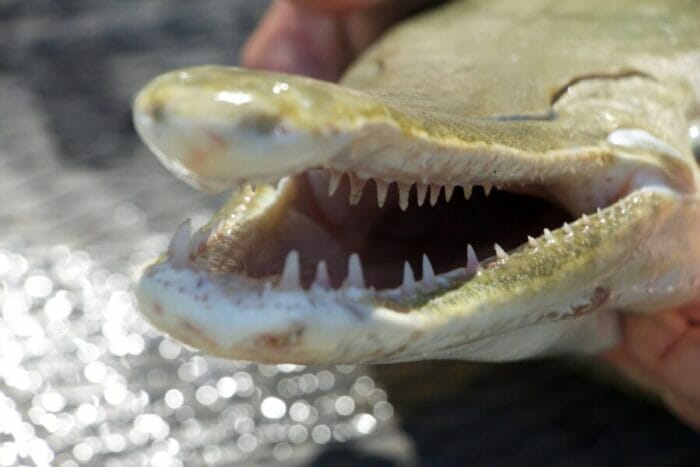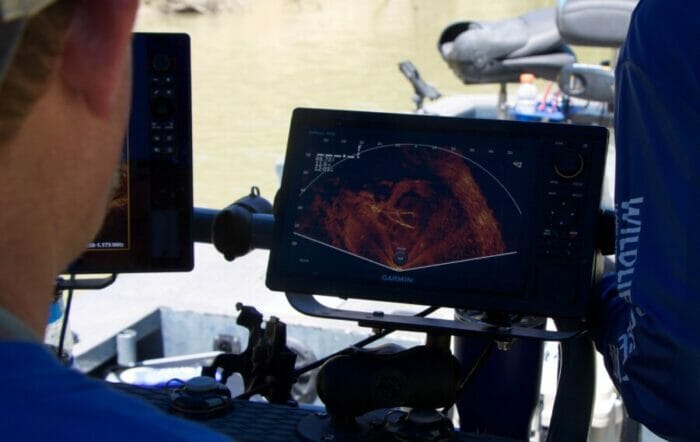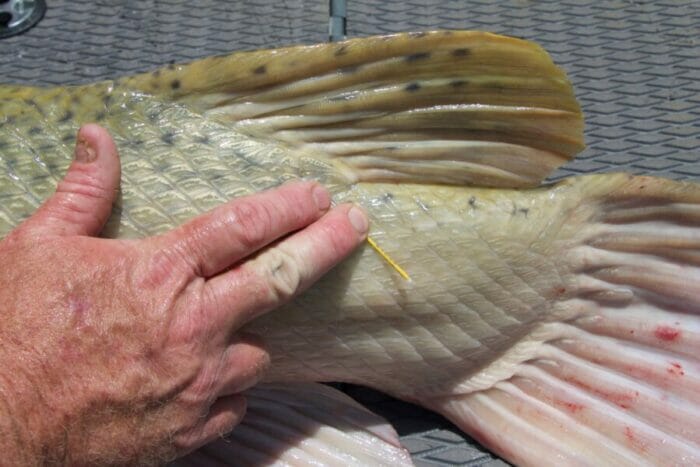Gar-ing
“Corey, I remember you working around the Trinity River and that part of Texas as a wildlife biologist when you were with TPWD. With the waterfowl and alligator work and research you did, you surely have seen some big alligator gars. But my question is, have you ever fished for them or caught one?” At the time, I was in Corey Mason’s DSC office, having just finished an episode of the weekly podcast “DSC’s Campfires with Larry Weishuhn,” interviewing him about recent DSC/DSCF goings-on.
“I have seen some huge alligator gar but never caught one. Seeing photos and footage of you and your daughter catching big gar on “A Sportsman’s Life” on CarbonTV, there is no doubt it would be great fun!” he replied.
“I’m glad you think so! I’ve booked a day on the Trinity for you and me with Alligator Gar Addiction’s Chris Moody. My daughter, Theresa, and I fished with him. We’re set to fish in late July. It’s a little late for the gar “bite,” but Chris does a fabulous job of putting clients on fish. It may be slower than usual. Still, I got a feeling he’ll get you on at least a nice gar.”
Trash to Trophy
What is the fascination with alligator gars, once considered “trash fish”? Many! The alligator gar has essentially remained unchanged for the past 100,000,000 years. They still look the same as the first fossil records of the species, and they are still essentially the same size. The oldest fossils are really no bigger or smaller than the bigger alligator gars we have today. Their boney scales are still true bone. They still have four nostrils and can breathe air or gain sufficient oxygen through their gills. They, too have an abundance of needle-sharp teeth. Their upper jaw has two parallel rows of teeth per side. The lower jaw, with its one row of teeth, fits in between the upper jaw’s two rows of teeth; all are designed to grasp and hold rather than cut. Their “snout” resembles that of an alligator, the reason for their name. Interestingly it is designed to expand to accommodate large prey. Their food includes fish, turtles, reptiles, birds, and small mammals. Alligator gars are truly freshwater’s “apex predator.” Add in alligator gars are the largest true freshwater fish in our North American waters. They can grow to in excess of 8 feet in length.
Recently an alligator gar was reportedly caught in the Trinity River (southeast of Dallas, Texas) that weighed in excess of 300-pounds and was 10 feet long. Unfortunately, there were no photos taken, nor official measurements or weight taken. Could such an alligator gar exist? It is possible but questionable! I have seen one that I thought approached 10 feet long in an oxbow of the Navasota River, southeast of Texas A&M University. Try as we might, we could not catch it before a flood covered the land and likely allowed the big gar to escape into the river.
The IFGA, which keeps fish records, credits the largest alligator gar caught on rod and reel as weighing 229-pounds. It caught in the Rio Grande back in the late 1950s. In visiting with Chris Moody with Gar Fishing Addiction about some of his previous catches, actually those of his clients, he replied. “My clients regularly catch fish that measure six feet, several each year that measures in excess of seven feet. The biggest we have caught was a bit over eight feet. I suspect based on what we know about length and girth measurements; we likely have taken some that would come close to breaking that record if not exceeding it.” He continued, “We don’t normally weigh fish, but we do take length and girth measurements.”
“We also participate in a tagging program. Every fish we catch is tagged with a state-issued small tube tag with an individual number. Information is recorded and provided to our local fisheries biologist. From the tags, we can learn about growth rates and movement up and down the river.”
“Larry, the fish you previously caught with me, we’ve caught twice more. It moved upriver a way. During the past year, she added one inch of length.” He went on to explain, “Alligator gar grow to about four feet pretty quickly. But after that, it seems they only add a half inch to one inch in length per year. Considering that, some of the bigger gars we have taken, all females, can be pretty old.”
Years ago, Chris had been one of the top bowfishing guides that guided his clients to really big gars, but that was in the past. “I thankfully came to the realization when you kill the big gars; they’re gone. But if you catch them on rod and reel, you can enjoy a fabulous fight, measure, tag, and take photos of that same fish before releasing her and likely catch her again in the future with someone else. Then they, too, can truly enjoy the experience. In our Trinity drainage, if you want to kill a big fish, you have to procure a “kill tag” from the Texas Parks and Wildlife Department. We do catch and release. And since we have caught several of our tagged fish several times, we know the fish we release are surviving.”
A Day on the River
Finally, the 27th of July arrived. Corey and I met Chris Moody, along with our mutual friend, Brandon Houston, my partner in H3 Whitetail Solutions, our wildlife management consulting business, all wild species and their habitat, at an appointed place. Brandon had volunteered to film for an upcoming episode of “A Sportsman’s Life” and a couple of other projects he and I are working on.
Before we launched Chris’s fully appointed fishing boat, ideal for fishing for big alligator gars, catfish, and crappie, he warned us. “I do not ever remember the water level being quite as low as it is right now, nor have I seen the water temperature this warm, almost 90 degrees. Fishing is likely going to be slow. They’re not biting like they normally do. We should catch a gar, but we also might. But we’ll give it our best try.”
Once we were on the river, said Chris, “Larry remember when you fished with me last time. We were almost constantly seeing or at least hearing gar surfacing and slapping the water. Have you seen or heard any do so?” Before I could respond, he added, “Come back here where you can see the live scope. See all the gar nearly beneath us and to our sides. The grid is set up for 5 feet. Compare the gar you can see to that grid.” As I did, I commented I had not seen or heard even the first gar surfacing or slapping the surface. But, on the live scope, I could see numerous gar that were easily 5 to 6 feet in length and at least a few that were nearly as long as two side-by-side grids. Those were likely very close to 8 feet in length, possibly longer.
Chris baited three lines each time we stopped in a likely-looking spot based on what he was seeing on the live scope. Each time we had several five to six feet and longer gars underneath and around the boat. The hooks were baited with prime cut-carp bait, including a couple of carp heads, a favorite of alligator gar.
We watched the floats. Only very seldom did they move. When they did, a gar had taken the bait and carried it in its mouth for a few feet but then dropped it!
Finally, a gar took the bait and swam upstream, according to Chris, indicative of a bigger gar, usually. “Corey, you’re up!” Said Chris. “Give her line and let her run with it.” A couple of moments later, “Reel in slack, then set the hook as hard as you can!”
Corey followed instructions to a “T.” He set the hook hard! The fight was on…well…at least for about fifteen heartbeats. Then the gar simply dropped the bait.
We moved downstream to another bend in the river, deeper water where the live scope showed an abundance of gar. Baits back in the water.
After ten minutes of “waiting for the bite,” a float started moving. Chris reeled in the other two lines. As before, Corey waited, giving line, giving line until Chris told him to set the hook. He cranked the reel one full turn to make certain there was no slack in the line, then set the hook. This time the gar was hooked. The fight was on!
Corey took line when he could. “Not a monster, but nice!” commented Chris. Just then, the gar’s head surfaced. “Maybe a little bigger than I thought. She’s got a big head!” The gar jumped, hit the water, and continued fighting.
“She is strong! They put up quite a fight!” commented Corey. Brandon filmed the action. The fish surfaced again, jumped, and continued fighting. Finally, she started tiring.
“Bring her alongside, so I can get a noose around her so we can pull her into the boat. Beware of her teeth!” Warned Chris. Moments later, he had a rope looped just behind her front fins, then pulled the near 5-feet long gar aboard. “She’s got the head of a six-footer but lacks the body!” Corey seemed pleased. We had a gar on board.
We took appropriate measurements, which Chris recorded, then placed a tag alongside of her back dorsal fin. After some photos, we released Corey’s catch. Congratulatory handshakes all around!
Wish I could tell you that was the first of several alligator gar we caught that day…but that did not happen. I knew Chris’ clients normally catch numerous gars each day. But it was not to be today. Chris had warned us the bite might be slow, and it was. Seemed repeated days of well over 100 degrees, and a lack of rain resulting in extremely low water was taking its toll.
Regardless we had a fabulous day on the river and told many hunting and fishing stories. Great fun! And…Corey had caught his first “real” alligator gar! I suspect it will not be the last time he fishes for the largest freshwater fish in North America.
Before leaving the river, I made arrangements with Chris to fish with him again next spring, probably May or June, before the summer’s heat and hopefully higher water level. Between you and me…I am on a quest to catch a 7-feet plus long gar. I know one of these days it will happen while I am fishing with Gar Fishing Addiction!
Professional wildlife biologist/outdoor communicator, Larry Weishuhn, known to many as “Mr. Whitetail”, has established quality wildlife management programs on over 12,000,000 acres throughout North American and other parts of the world. He has hunted big game with rifle and/or handgun on six continents. Larry is a Professional Member of the Boone & Crockett Club, life-member of numerous wildlife conservation organizations including the Dallas Safari Club, Mule Deer Foundation, and Wild Sheep Foundation. He currently serves on the DSC Foundation Board of Directors, is one of three co-founders of the Texas Wildlife Association; is a member of the Legends of the Outdoors Hall of Fame and the Muy Grande Hall of Fame; he too, received the Zeiss Lifetime Achievement Award among many other honors.






